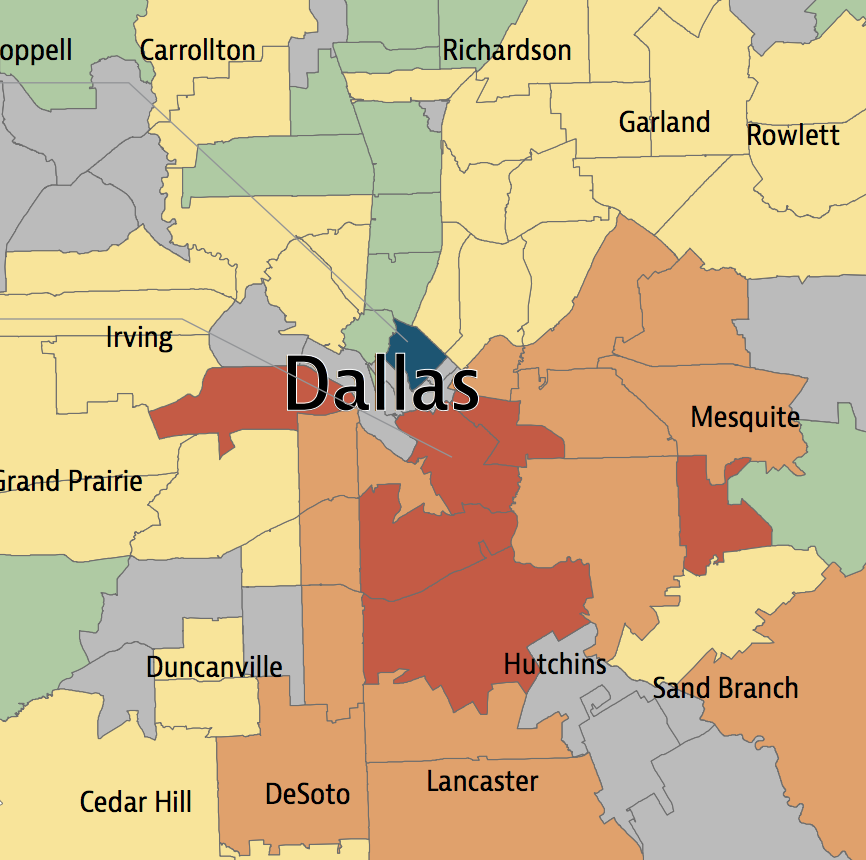
A new study from the University of Texas health systems shows that just two miles can mean 26 years of life expectancy in Dallas. Researchers at the UT Southwestern Medical Center Department of Population and Data Sciences has created an interactive map that shows how life expectancy changes between ZIP codes. Within each ZIP code, it allows users to see life expectancy differences between male, female, black, white, and Hispanic residents.
While much of the data lines up with what other social determinants of health have been telling us about how education, poverty, environmental and social factors impact overall health, but there were some interesting data points as well. There was at least one ZIP code in Texas where black, white and Hispanic residents each had a life expectancy over 90 years, and another with one below 73 years for all three groups. Hispanics had the longest life expectancy overall, with one San Antonio ZIP code showing a life expectancy of 99 years for Hispanic residents. Hispanic people on average live three years longer than white people and 5.9 years longer than black people.
In Dallas, ZIP Code 75204 in Old East Dallas is the area with the most longevity, where men live to be 90.1 years old on average. Just two miles south in ZIP Code 75215 in South Dallas, men are expected to live just 63.6 years, according to the study. In Fort Worth, ZIP code 76104 had the lowest overall life expectancy in Texas, at 66.7 years.
Predictably, the study found that as the number of people living below the poverty line increased, life expectancy went down. If your ZIP code has less that five percent poverty, the life expectancy is 82.4 years, whereas ZIP codes with more than 20 percent of people living in poverty had a life expectancy of 76.4 years.
Statewide, women are likely to live to be 81.1, while men will be 75.9 on average. Life expectancy is 81.2 years for Hispanic Texans, 78.1 years for white Texans, and 75.3 years for black residents. Texas’ average was 78.5 years.
Dr. David Lakey, UT’s Vice Chancellor for Health Affairs who was also the Texas Commissioner of Health for eight years, saw the need for the study after years of looking at statewide data. “It was apparent to me when I was Commissioner of Health that your chances of living a healthy life depend on where you live and your ethnicity,” he says. While there were studies that measured statewide data, the reality of situation was lost because of disparities between smaller areas within the state. Even county level measures can hide life expectancy disparities, as noted in the above difference between south and east Dallas.
Because the study overlays ZIP codes with ethnicity and gender, the data will allow health providers, nonprofits, and government entities to address issues in a more granular and specific way. For Lakey, the data shows just how important one’s immediate environment is. “Our community is structured to allow us to be very healthy or keep us from being healthy,” he says. “You can tell us to go out and run, but if there is a dog biting me when I run, or there aren’t safe sidewalks in my community, those things can contribute to our ability to live a healthy life.”
The higher life expectancy of the Hispanic community, which is on average less wealthy than white people in Texas, seems to be flying in the face of other social determinant trends.”We don’t totally understand that, but there are a lot of theories,” Lakey says. He notes that it is unlikely to be genetic, but is probably due to Hispanic social structure, where households are more likely to consist of multiple generations, which could impact how that population ages.
Lakey looks to a number of places to help reduce the ZIP code life expectancy disparity. He says infant and maternal mortality, which disproportionately impacts black women in Texas, are good places to start. He says organizations have connected during the Healthier Texas summit to collaborate on best practices to improve health in the states.
From a business perspective, he knows that this life expectancy is also a measure of healthcare costs, and can impact where businesses decide to relocate. “If a ZIP code is better in one area versus another, the company won’t move it to that area,” he says.
Lead investigator and UTSW professor Dr. Sandi Pruitt highlights the importance of zooming in to this level. “We knew that where you live is predictive of health, but the degree of variation that we observed in this study was really striking, down to the ZIP code level,” said Pruitt via release.
Read the study here and explore the interactive map here.




